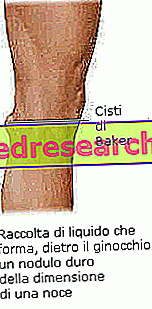What is a cyst?
The cyst is a closed bag or cavity of a pathological nature, covered with epithelium and filled with liquids, gas or semi-solid material. When the accumulation is not covered by a very distinct membrane one speaks instead of pseudocysts .
Cysts can develop at any age and in the most disparate locations, generally quickly before stopping their growth permanently; more rarely, these abnormal formations shrink or continue to increase in size.
The cysts are very numerous in variety and only in a very small percentage of cases are they spies of a malignant tumor.
Insights on the Various Types of Cysts
Dental Cysts Calazio Ovarian Cysts Geodes, Subchondral Geodes - Bone Cysts Polycystic Kidney Baker Cysts Breast Cysts Tendinic Cysts Sebaceous Cysts Pilonidal Ganlia (or Synovial Cysts) Bartholin Cysts to the Dermoid CystCauses

The most common, the so-called retention cysts, originate from the obstruction of a glandular duct; among the various examples, the most characteristic is given by the sebaceous cysts, which are formed precisely in the sebaceous glands of the skin, often at the level of the genital area or of the scalp. These formations, which can reach considerable dimensions, contain the secretion product of the gland (sebum), which is sometimes infected.
Cysts can also be formed due to infectious processes, chronic inflammatory conditions, tumors, genetic diseases or during fetal embryo development (eg dermoid cysts ).
Symptoms
Cysts may produce more or less intense symptoms or be completely asymptomatic, depending on the size, number and location of development. The larger mammary cysts, for example, although clearly palpable and of a hard or soft consistency, are harmless and do not present dangers (they are not cancers and are not more likely to become so); however they can cause pain or a feeling of discomfort.
Diagnosis
Depending on the location and size, cysts may be visible to the naked eye or under a microscope, and may or may not be detected on palpation; in these cases, a fundamental aid to diagnosis is provided by imaging techniques (radiographs, ultrasound scans, CT scans, magnetic resonances, etc.).
Cures and treatments
If the cysts are painful or cause other problems to the patient (eg psychological), they are surgically removed, drained or aspirated through a needle or catheter. If necessary, for example when cysts develop in internal organs, the operation is performed with the aid of imaging techniques. If instead it is suspected that the cyst hides a malignant tumor, before proceeding with the removal it can be subjected to biopsy to dispel any doubt. Anatomo-pathological examination can also be conducted on a sample of the internal liquid. Finally, if the widespread presence of cysts is one of the characteristic signs of an underlying chronic pathology, the treatment is generally aimed at the causes of origin (for example in the presence of multiple ovarian cysts an attempt is made to reduce the production of androgens by the ovary).



